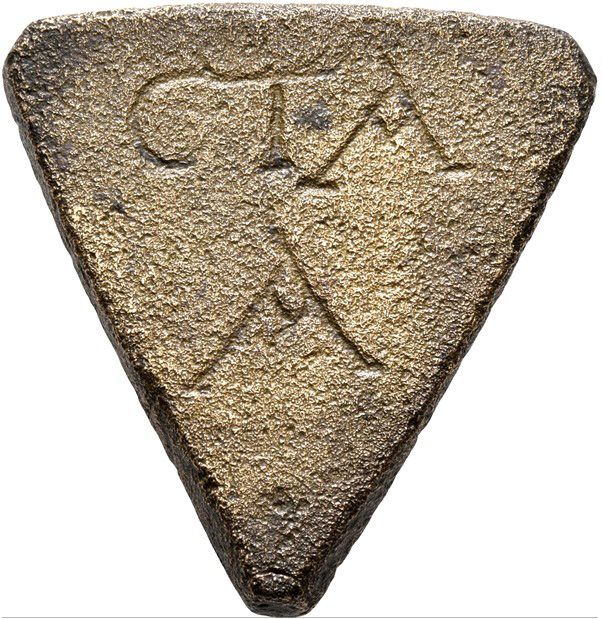
-
Copyright credit: Auction Leu 2019

ARCHAEOLOGICAL DESCRIPTION OF THE WEIGHT
Authority
Mint
Denomination
1 Stater
Material
Copper alloy (bronze or brass)
Manufacture
Cast
Shape
Triangle
Length
2.50 cm
Width
- cm
Height
- cm
Metrology
| Mass (g) | Mass (grain) | Date of measurement | Reference | fragmented | cleaned | reference weight |
|---|---|---|---|---|---|---|
| 14.11 | - | - | Auction Leu 2019 | No | No | Yes |
Iconography
| Symbol | Technique | Direction | Position | Number | Synecdoche |
|---|
Wear
Corrosion
Handle
No
Suspension hole
No
Recarved mould
No
Recarved weight
No
Intentionally destroyed
No
Archaeological description
Auction Leu 2020: Weight of 1 Stater (Bronze, 25 mm, 14.11 g), a triangular coin weight with inscribed edges, 1st century AD. CTA / A; on the edges, ЄTOYC - [.]T[.] - KAI HNT. Rev. Blank. Unique and of great interest. Patina stripped, otherwise, very fine.
Autopsy
No
INSCRIPTION
| Language | Technique | Legend type |
|---|---|---|
| Greek | Incised | Date, Denomination |
Fac simile
CΤΑ
Α
ЄTOYC [.]T[.] KAI HNT
Edition
Στα(τήρ) | α´. || Ἔτους | [δ´ (?)] τ[οῦ] | καὶ ηντ´.
Monogram
ARCHAEOLOGICAL CONTEXT
Findspot (region)
Findspot (site)
context
CIRCUMSTANCES OF ACQUISITION
Region
City
Date of first acquisition
Feb. 24, 2019
circumstances
Antiquities trade.
DATING OF THE WEIGHT
Curatorial Section
GREEK
,
ROMAN
Time frame
FROM
1
TO
200
Comments on Chronology
Year 358 of unkown era = 3[..]?
COLLECTION HISTORY
Collection
| Name | Date of acquisition | Inventory number |
|---|---|---|
| Hadad Collection | Feb. 24, 2019 | WHW 22 |
Bibliography
| Reference | Page/Column | Reference (number) | Plate / Figure | Comment |
|---|---|---|---|---|
| Auction Leu 2019a | None | 1826 | None | None |
| Korshenko 2021 | 20–22 | None | None | None |
VARIA
Additional comment
Auction Leu 2020: This very interesting weight for a stater bears two dates on its edges, of which unfortunately just one - HNT = 358 - is fully readable. We do not know which eras were used, but since both years are larger than 300 (T = 300), and considering the fact that the earliest known eras start in the late 4th century BC, the weight dates to the early Roman Imperial time at the earliest (if 358 is to the Seleukid Era, this would correspond to 46/7 AD). Such a late dating corresponds to the use of the lunate epsilon and sigma, but it also poses a problem as no staters of such a weight circulated in the Mediterranean region in the Roman era. Could it be that the weight was used somewhere in the Levante for autonomous Tyrean shekels, which were being struck well into the 1st century AD and which weighed around 14.0-14.3 g?
See https://pondera.uclouvain.be/artifact/14266/
See https://pondera.uclouvain.be/artifact/14266/
Permalink
External link